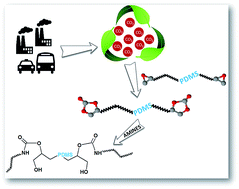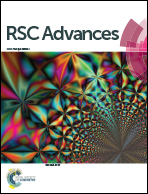Hybrid urethanesil coatings for inorganic surfaces produced by isocyanate-free and sol–gel routes: synthesis and characterization†
Abstract
A simple and versatile route for the preparation of self-adhesive, corrosion-resistant and photochromic hybrid coatings is presented in this paper. The coatings are based on aliphatic poly(dimethylsiloxane)-derived hydroxyurethanes (PDMSUr), produced by the isocyanate-free route for inorganic substrates such as glass and metal alloys. This route involves the ring opening polymerization of a PDMS-derived bis(cyclic carbonate) (CCPDMS) with diamines and aminosilane. The cyclic carbonate was synthesized by cycloaddition of CO2 into a PDMS diglycidyl ether. The use of aminosilanes with CCPDMS enables hybrid organic–inorganic urethanic coatings to be obtained by the sol–gel process. The crystallinity of the coating can be easily controlled through the interplay of the ratio of monoamines and diamines in the formulation. The hybrid PDMSUr materials were tested as an adhesive/coating for metallic and glazed surfaces, presenting adhesion strengths of up to 7 MPa and a maximum usage temperature of 160 °C. The incorporation of phosphotungstic acid (PWA) produced a hard material (20–60 MPa) and the elastic modulus rose by more than a hundred times as the PWA content increased. The hybrid PDMSUr 2_35% PWA presented photochromic properties and is suitable as an adhesive and impact damping layer for laminated glass used for smart window production. Furthermore, these coatings are suitable for the protection of metallic substrates against corrosion in acidic, basic and seawater media.


 Please wait while we load your content...
Please wait while we load your content...